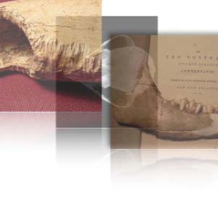Vertebrates in Caves
Description
This research began with work on assemblages from caves in the Craven region of North Yorkshire, which is well known for its karst landscape and numerous caves. Some of these caves contain Pleistocene and Holocene deposits with evidence of past human activity. In others, bones of Lateglacial date show tooth-marks indicating that they have been gnawed and chewed by large carnivores, probably wolves. Wolf bones have been recovered from several Lateglacial sites in the region, and there are numerous records of bear and of lynx. The project started with a re-examination of some of the bones from Sewell's Cave (SD 785666), originally excavated in 1933-34. This investigation located cut-marks consistent with a lithic blade on some of the specimens.
This is an important observation for two reasons:
- the Sewell's Cave material is dated to the final phase of the Lateglacial Interstadial, with three statistically indistinguishable AMS-radiocarbon dates around 10,740BP - the cut-marks confirm the presence of people in the region late in the Interstadial
- the cut-marked bones have been quite heavily gnawed, and this, together with their location within the cave, indicates that they were accumulated by wolves - the implication is that wolves were scavenging kill or processing sites used by hunter-gatherers, and removing bones to the cave.
Subsequent research has focussed on understanding the taphonomy of cave assemblages, building a collaborative association with cavers active in the region, and developing a synthesis of cave palaeontology in the Yorkshire Dales, published as:
O’Connor, T. and Lord, T.C. 2013. ‘Cave Palaeontology’, in T Waltham and D Lowe (eds). Caves and Karst of the Yorkshire Dales. Buxton, British Cave Research Association.
Progress and results
The project has since moved on to assemblages from other caves in the region. At Victoria Cave, material recovered in the 1890s has been shown to include remains of bears that probably died in hibernation and decayed more or less in situ, fragments of reindeer bone that have been chewed and cracked open by wolves and were probably hunted by the wolves, and remains of horse and aurochs on which there are wolf tooth marks and lithic cut-marks, indicating that the wolves were scavenging human kill-sites.
This is a much more subtle analysis than has previously been undertaken on Late Pleistocene material from the UK and it is reported in full in:
- Lord, T.C., O'Connor, T.P., Siebrandt, D.C.and Jacobi, R. 2007. People and large carnivores as biostratinomic agents in Lateglacial cave assemblages. Journal of Quaternary Science DOI: 10.1002/jqs.1101
Excavation work in Kinsey Cave in 2005, in collaboration with Tom Lord and with Tim Taylor (University of Bradford) located Early Neolithic deposits of human and animal bones, the latter including domestic livestock and wild species. Associated with the deposit was a spread of small vertebrate bones, including abundant amphibians. These 'frog-earth' deposits have been noted in other caves, but there has been little detailed analysis.
A thorough study of the material by One Tshukudu (MSc Zooarchaeology student) showed the assemblage to consist of frog, toad and small rodent bones, some of which showed crushing and tooth-marks indicating their deposition by a mesocarnivore predator. Likely candidates are badger and polecat, either of which may have been using the cave long-term as a den. Investigation of a similar assemblage from Steetley Quarry cave (collaboration with Oxford Archaeology) by Rebecca Knight showed it to be of similar origins, though of earlier date.
Bear remains from the caves have been revisited in a project that combined new direct dating with mtDNA analysis to test a series of questions about the population movements of bears during the climatic fluctuations of the Late Pleistocene to Early Holocene. Bears are useful proxy evidence for the productivity of landscapes during this period, as a landscape that could support bears was probably capable of supporting people, too. Our results have been published as:
Edwards, C.J., Ho, S.Y.W., Barnett, R., Coxon, P., Bradley, D., Lord, T.C. and O’Connor, T.P. 2013. Continuity of brown bear maternal lineages in northern England through the Last-glacial period. Quaternary Science Reviews online: DOI http://dx.doi.org/10.1016/j.quascirev.2013.10.015
Future
New work by cavers has yielded Early Holocene faunal material from caves in the north-western part of the Dales. Aurochs bones from these new assemblages will form part of a larger study of aurochs in Dales prehistory, addressing questions about the date of local extirpation of this keystone species, and relations between aurochs and the first Neolithic farmers in the region. We know from direct-dated cattle and sheep bones that domestic livestock reached the Dales shortly after 3900BC, so domestic cattle and aurochs had centuries of co-existence.

